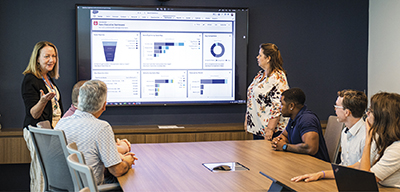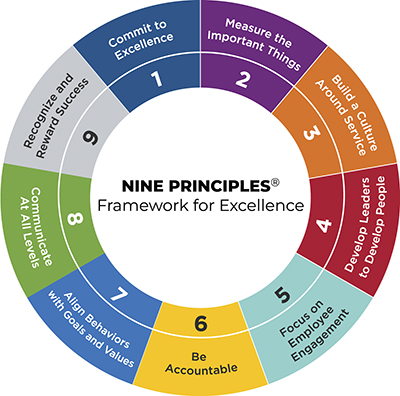Growing a Great Culture for Work and Learning
November 01, 2022
Executing ‘always actions’ can help an organization cultivate excellent team leaders

Strong relationships within a school system are foundational to the well-being of our people and the success of our students. Success depends on the full team’s ability to create a great place to learn and work. Building the conditions for a strong culture was challenging before COVID-19. It’s even more so now.
In my state of Wisconsin, 25 percent of the superintendents are new to their school districts this fall. Many of them and other district leaders across the country started the year with critical staff positions unfilled. Angry national politics have been migrating to board meetings and local school board elections. Deeply committed school board and community leaders are losing their seats due to well-financed, politically charged campaigns. Board majorities are flipping.
Strong executive teams in K-12 education know the health of each school and success of all students depends on their ability to grow skilled, confident leaders at every level of their complex organizations. Building leader capability and the organization’s capacity to hardwire core actions and sound processes require a sustained focus on an aligned framework for developing their leaders.
Behaviors, Not Titles
Leadership “maturity” isn’t about years of experience.
Skilled leaders learn how to show up together as one team for everyone they serve. They stop chasing isolated initiatives. They lead with a shared commitment. They know healthy cultures produce strong results. The Nine Principles for Leading Organizational Excellence, developed by Studer Education, frame the guiding principles for skilled leadership development and aligned processes that can lead to schools that are great places to learn and work.
Skilled leadership becomes a behavior, not a job title. When teams and students are under stress, their leaders lean in to provide the right support at the right time. Time is prioritized for the people we serve. Skilled leaders work alongside their students, families and team members to remove barriers to success and build a collective energy that makes it possible to solve any challenge when everyone works well together.
Aligned Actions
Just as we focus on high-leverage strategies for effective teaching, there are what we call “always actions” for sound leadership. I will focus on a few of the “always actions” for leadership that are aligned to the nine principles. These are important to supporting our staff members when they work around obstacles, communicate regularly and ensure a strong culture exists at every level.
This process creates a people-first culture. Skilled leaders prioritize the time needed with their people. They work alongside staff and students closest to the work to remove barriers.
A few types of “always actions” are leader rounding, scaffolding of two-way communication and team huddles.
Leader rounding. We understand the concept of “management by wandering around.” Being visible is important, yet visibility alone will not address the specific needs of your team members or resolve the challenges worrying them.
Leader rounding is purpose-filled and executed with intention. The why behind rounding is simple. We schedule time (usually 10-15 minutes) to listen to staff members closest to doing the work. We hold individual conversations with a few key questions. Leaders learn what is working and who is making a difference. The leader understands the barriers and what support may be needed.
The rounding process becomes a leader’s “always action.” The process hardwires leaders at every level, celebrating what is working and working with clarity to effectively remove barriers. The simple questions can be adjusted based on the needs at that time. (See box, right.)
Often barriers are simple to address. The committed time to check-in makes the difference. Getting messages from each team member allows the leader to prioritize and solve the problems the team is experiencing. Leader actions become targeted. The impact can be powerful.
Rounding demonstrates leaders are working alongside the team. There’s a commitment to listening and solving for the barriers being experienced by those closest to the work. When a team is healthy, rounding on a quarterly basis works. When individuals are feeling stressed, leaders should prioritize the time to connect more frequently — as often as needed to effectively solve the real challenges. It may be daily during a time of crisis or every other week to ensure new staff members have the support they need when they need it.
Rounding with students is equally powerful. Teachers and leaders can use the same base protocol with students individually or in small focus groups, depending on the level of stress and the complexity of their needs. This process ensures deep listening with intentional follow-through.
Scaffolding two-way communication. Few things cause more anxiety than the poor flow of information. Leaders typically carry too much information in their heads. The flow of communication is too slow to keep people updated on topics they feel are critical. The lack of information fuels mistrust and wounds the culture. Intentionally scaffolding communication means leaders work together to hardwire processes that ensure healthy two-way communication.
The leader “always actions” that enable two-way feedback include three core processes: (1) key words at key times; (2) a plus-delta process; and (3) team huddles.
Key words at key times. Employing key words at key times simplifies important messages to the essentials. It explains why the information is important and how it answers the questions raised by the staff receiving the update.
Effective two-way communication starts with the input leaders receive during staff rounding. Listening directly to staff helps leaders better understand issues impacting staff and dedicated time to seek insights on the actions that may resolve the problem. The communication becomes two-way and more intentional.
Leaders share the steps they are taking to tackle the challenges important to the staff. It sounds simple. The impact is profound. This process demonstrates the challenges impacting staff are being taken seriously and their input is valued.
Examples of key word communications that use plain language include: “This message is to share an update on our open aide position. Thank you for sharing your input and concerns for student safety during our noon recess. The input has helped identify a short-term schedule change to meet the need for noon recess support.
“I anticipate the hiring process will be complete by November 1st. Jorge will fill this role until November 15th. A special thank you to Jorge and April for your flexibility and willingness to mentor our new team member. Please e-mail me with any additional questions or input. We will be reviewing the process we use to communicate job openings and recruit candidates at our Tuesday morning meeting. Your ideas are helpful.”
When faced with key challenges, leaders need to provide frequent, focused updates. Everyone wants to understand the problem-solving efforts underway. Scaffolding the communication acknowledges who is involved and impacted, and what actions are being taken. Finally, key words should outline how leaders will keep everyone informed and how people can follow up with questions or seek clarification. Information may be delivered live, in writing or through video. A well-structured message is key.
A plus-delta process. Delta means change or a need for focus, “plus” starts by asking “What is working well?” Plus-delta employs a feedback loop with a small team sharing their
thoughts either orally or on Post-it notes. It can take five minutes at the beginning or end of a team meeting. Key questions may be these: “What has gone well over the last two weeks?” or “What is worrying you most as we start the
new year?”
Team huddles. Leaders may be reluctant to schedule regular team meetings. The mindset of “let them do their real work” can be self-defeating. Leaders may be left unaware of the needs of their team members. Team members may be left to firefight critical issues alone. Everyone is caught up in a swirl of reactive behavior.
Meetings need not be long to be impactful. Brief huddles that last no more than 15-20 minutes enable teams to share progress reports.
Under normal circumstances a weekly huddle may work. When stress is high, the need accelerates. Leaders impacted by a wildfire held daily 15-minute Zoom huddles at 7 a.m. for four weeks to effectively scaffold communication. Those closest to a challenge gather to process what is working, assess whether planned actions are working and determine next steps. Virtual huddles are effective if members are located across different sites.
To intentionally grow leaders at every level requires long-term commitment, but the results can be transformative. I’ve seen leaders and their full teams move beyond reactive crisis management. These leaders learn how to assess barriers, problem-solve effectively, scaffold communication, and execute proactively to ensure student and staff success. This is what is needed to grow great team leaders. Systems are capable of becoming a bit better each day at meeting the needs of those they serve.
Patricia Greco, a retired superintendent from Menomonee Falls, Wis., is senior director of thought leadership with Studer Education in Pensacola, Fla.
Principle 1: Commit to Excellence

Set high expectations to achieve results while living out mission and values.
Principle 2: Measure the Important Things
Continuously track progress to achieve results with an improvement mindset.
Principle 3: Build a Culture Around Service
Serve others with great care and concern.
Principle 4: Develop Leaders to Develop People
Coach people to be their best at work.
Principle 5: Focus on Employee Engagement
Attend to aspirations and desires in the workplace.
Principle 6: Be Accountable
Commit to individual accountability to achieve organizational goals.
Principle 7: Align Behaviors with Goals and Values
Help people know why what they do matters.
Principle 8: Communicate at All Levels
Apply consistent practices to move the organization in a positive direction.
Principle 9: Recognize and Reward Success
Value and appreciate people working together to get results.
Source: © Studer Education
Leader Rounding Protocol
Open with a warm connecting conversation: “Hi Simone, how was your camping trip with your family?”
- What is working well?
- What has been a challenge?
- How could I be helpful?
- Do you have the resources and support you need?
- Who has been helpful to you?
Team Huddle Protocol
- Greet, welcome, roll call. (one minute)
- Harvest a win from the team. (Select one person to contribute.) (one minute)
- Communicate something recognized as a positive from rounding. (one minute)
- Make announcements as needed. (two minutes)
- Discuss key actions for the day: Ask “Are we on-track or getting stuck?” (10 minutes)
- Ensure a flow of two-way communication, identify issues requiring problem solving that should move to a future meeting with a longer agenda or assign them to a small team to tease through the issues.
- Request input on what issues are percolating in the next 24 to 72 hours or in the next week. (15 seconds per team lead)
- Ask how team members are doing on key actions and key measures. (30 seconds per team lead)
- Inquire whether people feel stuck and need support. Ask the team what issues are keeping members from having a great day or week that need to be solved. (90 seconds per team lead)
- Summarize the priorities and set the time span needed for the next huddle.
Advertisement
Advertisement
Advertisement
Advertisement



